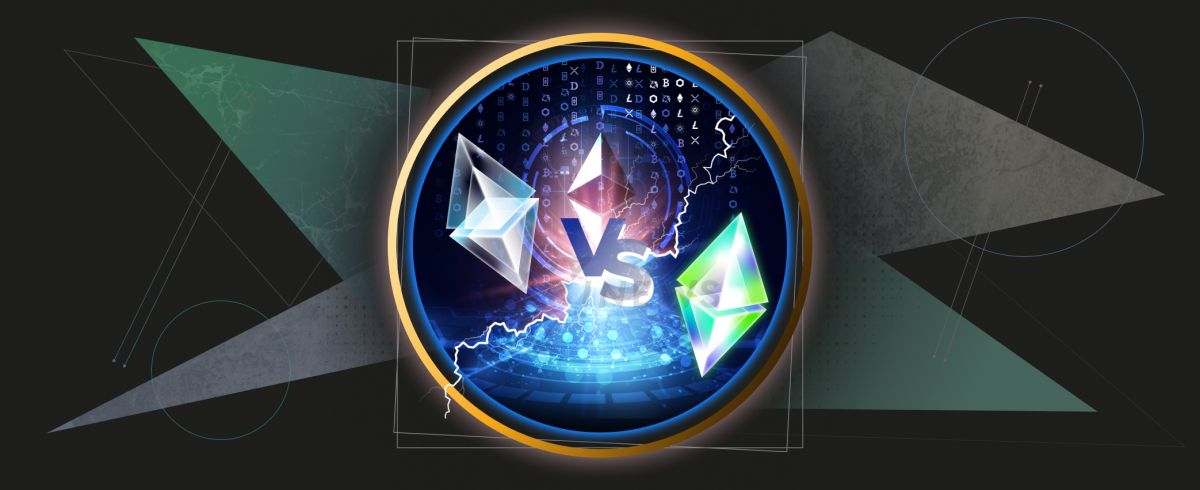Ethereum and Ethereum Classic: what is the difference

Is it possible for a father to be born after his son? Everything is possible in the world of cryptocurrencies. After all, this is precisely what happened to Ethereum Classic, which retained the base code of its progenitor – ETH.
On this page
How did ETC come about?
Ethereum Classic is a cryptocurrency that appeared in 2016 during the split of Ethereum. Then Vitalik Buterin, Anthony Di Iorio, and Joseph Lubin decided that after the Ethereum DAO hack and the loss of 3.6 million coins, it was necessary to update the blockchain to remove fraudulent transactions and return money to users.
Opinions in the community were divided, and part of the community did not agree with such changes. In defense of their point of view, opponents of the changes argued that if the saved history of transactions can be edited, even for a good purpose, then the blockchain will lose the basic idea of immutability.
And it's hard to disagree with this view of decentralization.
But the founders insisted and carried out a hard fork.
The paths of the two Ethereums diverged. One of them, updated, with the memory of the hack erased, returned the stolen assets programmatically and went his own way under the leadership of Buterin. The second one was supported by the teams of Igor Artamonov, Charles Hoskinson, and Gavin Wood.
Ethereum Classic has adopted an immutable Ethereum ledger that contains all transactions after the hack. For “code is law”, as stated in The Ethereum Classic Declaration of Independence.
The Ethereum Classic blockchain, like the Ethereum network, supports smart contracts and decentralized applications and uses EVM (Ethereum Virtual Machine) capabilities. But that's where their similarities end.
What is the difference between ETH and ETC now?
The most obvious: Ethereum is ranked 2nd by market cap and is not going to give up its position. Ethereum Classic is outside the top ten of cryptocurrencies. Sometimes the project climbs to 18th place, but more often, it remains in the third echelon (24th place according to CoinMarketCap press-time).
ETC does not follow the same price trajectory as ETH. And one of the reasons for the price difference is that ETC has a fixed supply while ETH does not have a supply floor. The maximum supply of ETC is set at 210.7 million coins, while the reward for miners per block is reduced by 20% for every 5 million blocks.
Since its launch, Ethereum Classic has strived to be different from ETH, with the two networks' technical characteristics diverging more over time.
The Ethereum blockchain switched to PoS, which significantly reduced electricity consumption and gas fees.
The Ethereum Classic blockchain still uses the energy-consuming PoW algorithm. That is, new coins are mined using traditional mining.
The ETC blockchain was hit by a 51% (double spend) attack three times – in January 2019 and in July and August 2020. In total, more than a million ETC were stolen. The team returned all stolen funds to users' accounts.
Attackers tried to hack the ETH blockchain in September 2021 but failed.
Ethereum Classic has a clearly stipulated monetary policy: miners know precisely how much they will be rewarded and how many blocks are yet to be mined.
As for rewards and fees on the ETH network, they are variable and depend on many factors: validators currently have to lock up at least 32 coins indefinitely to be eligible to create new blocks. At the same time, interest rates and the inverse square root function are used to calculate remuneration.
It can be summarized that Buterin's new Ethereum is technologically stronger and successful, despite signs of blockchain centralization and the lack of a coherent reward system.
And Ethereum Classic has retained all the features of cryptocurrencies as they were at the stage of their formation: fair distribution, transparency, and immutability.
Does Ethereum Classic have a future?
Right now, the ETC developers are focused mainly on supporting the concept of code as law. This means that no one has the right to censor the execution of code on the blockchain. Ethereum Classic still makes it easier to execute smart contracts, offers the benefits of decentralized governance, and has no plans to abandon mining.
But Ethereum continues to dominate Ethereum Classic as the blockchain of choice for buying, selling, and creating NFTs. This does not mean that ETC has no future. But ETH is likely to remain the more trusted and popular blockchain of the two. And this is the merit of marketers and the PR department of the Ethereum Foundation. They created a global school for developers on the Ethereum blockchain. In addition, the company tries to maintain friendly relations with regulators and enters into cooperation agreements with private and public companies, e.g. UNICEF.
We’d like to add that being rich and successful isn't necessarily the path to happiness. Not without reason, one of the Ethereum co-founders, Anthony Di Iorio, left the team in 2021 and decided to abandon all crypto projects. He explained this by personal safety concerns: the overwhelming success of the company and the millions earned forced him to hire bodyguards, without whom he did not leave the house.
The content on The Coinomist is for informational purposes only and should not be interpreted as financial advice. While we strive to provide accurate and up-to-date information, we do not guarantee the accuracy, completeness, or reliability of any content. Neither we accept liability for any errors or omissions in the information provided or for any financial losses incurred as a result of relying on this information. Actions based on this content are at your own risk. Always do your own research and consult a professional. See our Terms, Privacy Policy, and Disclaimers for more details.

























